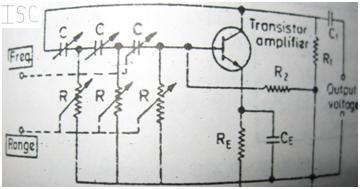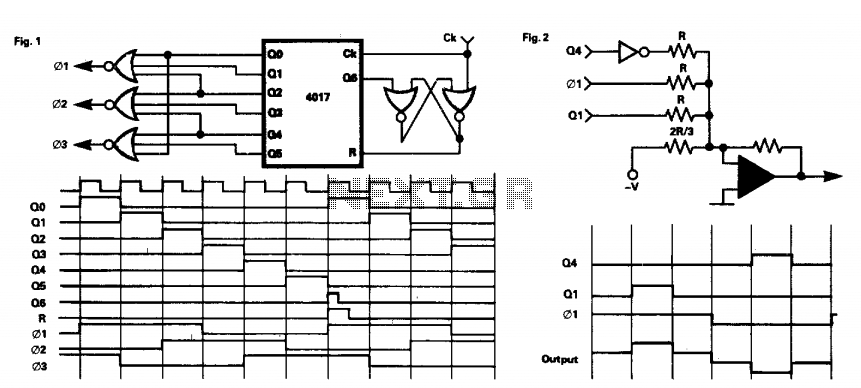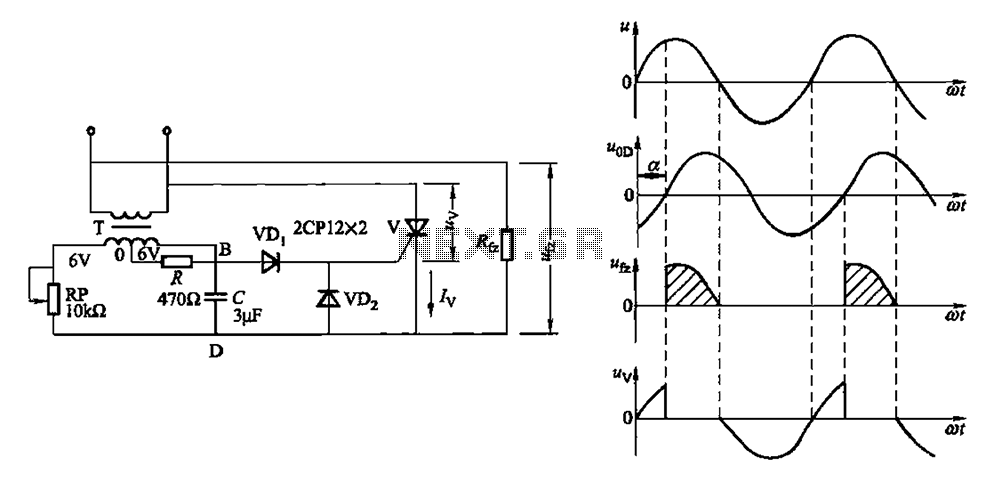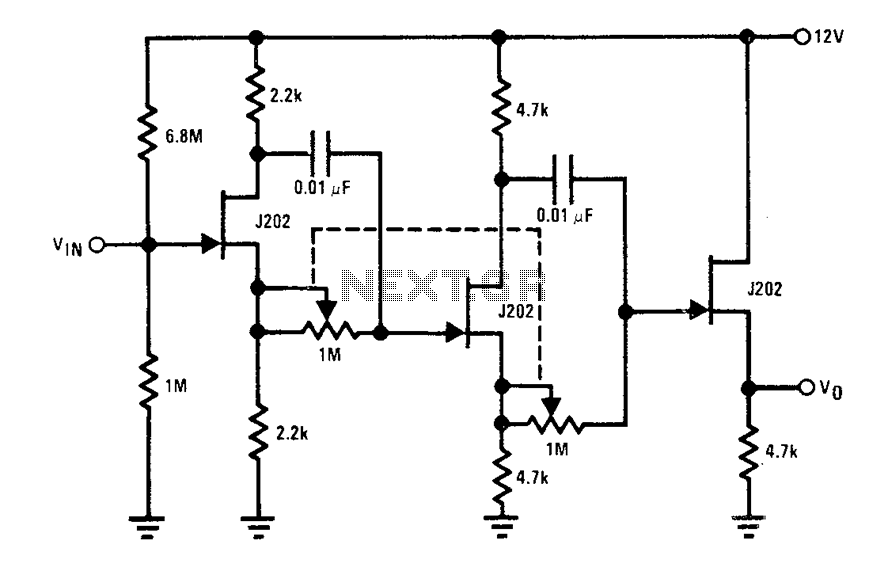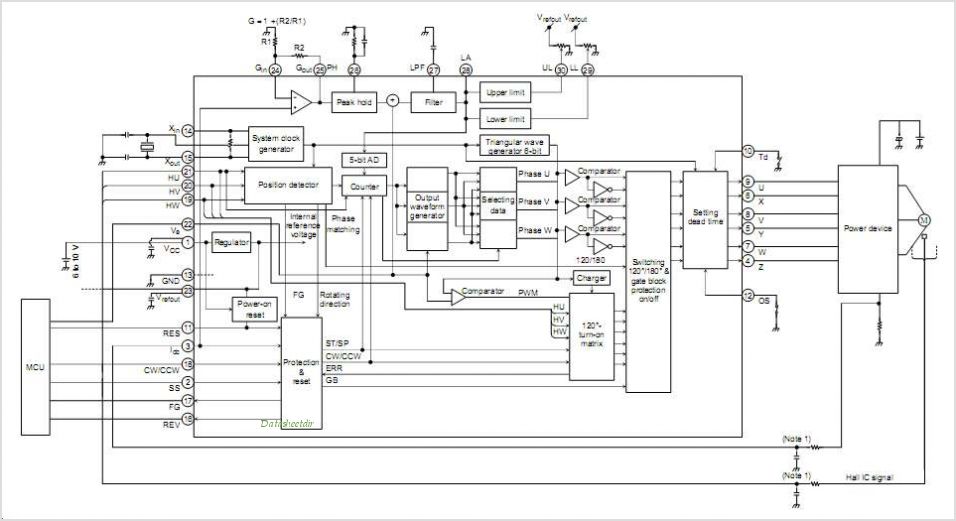
Phase Shifter
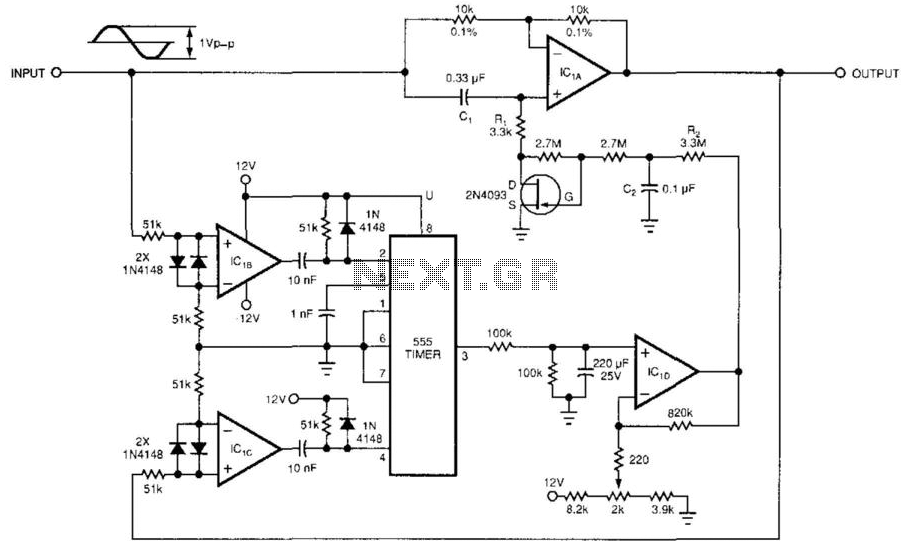
This circuit introduces a 120-degree phase shift to a 50- or 60-Hz input, regardless of fluctuations in frequency and amplitude. It utilizes a 2N4093 JFET configured as a voltage-controlled resistor, where its resistance value is proportional to the phase difference between the input and output. The components Q, Ri, and rs determine the phase shift amount (120 degrees in this case). A 555 timer functions as a phase detector, with its two inputs connected to the input and output signals. The signals drive IC1B and IC1C, which act as zero-crossing detectors. Diodes D1 and D2 limit the positive-going pulses at the inputs of the 555 timer. Consequently, the falling edges of the outputs from IC1B and IC1C control the 555 timer. The output signal from the timer remains low for a duration proportional to the phase shift between the circuit's input and output. The average output value from the timer, along with an offsetting voltage, drives IC1D. Capacitor C2 and resistor R2 filter the output of IC1D. The resulting signal regulates the JFET. A potentiometer adjusts the control value to achieve a 120-degree phase shift between the input and output when the input signal frequency is either 50 or 60 Hz. Any discrepancies between the input and output alter the average value of the 555 timer's output, thereby modifying the control voltage and the resistance of the JFET. To calibrate the circuit, a 50-Hz sine wave with an amplitude of less than 1 Vpp should be applied to the input, and the potentiometer should be adjusted until the phase shift reads 120 degrees on a digital phase meter. For input frequency variations ranging from 40 to 60 Hz, the phase shift varies by a maximum of ±0.17% (equivalent to an offset of only 0.02°/Hz). The average value at the non-inverting input of IC1D is 3.864 V.
The circuit operates by leveraging the characteristics of a JFET to achieve variable resistance, which is crucial for adjusting the phase shift. The use of the 555 timer as a phase detector allows for precise measurement and control of the phase relationship between the input and output signals. The zero-crossing detectors (IC1B and IC1C) ensure that the phase detection is accurate by responding to the zero crossings of the input and output waveforms, effectively providing a clean transition for the 555 timer to process.
The diodes D1 and D2 serve to protect the 555 timer inputs from excessive voltage levels, ensuring that the circuit operates within safe limits while maintaining signal integrity. The filtering stage comprised of R2 and C2 smooths out the output from IC1D, providing a stable control voltage to the JFET. The calibration process is essential for achieving the desired phase shift, and the specified sine wave input ensures that the circuit can be tuned accurately.
Overall, this circuit design is robust, capable of maintaining the specified phase shift across a range of input conditions, making it suitable for applications requiring precise phase manipulation. The careful selection of components and configuration allows for minimal variation in performance, even with frequency changes, underscoring the reliability of this phase-shifting circuit. This circuit adds 120 degrees of phase shift to a 50- or 60-Hz input, regardless of the frequency and amplitude fluctuations of that input. The circuit configures a 2N4093 JFET as a voltage-controlled resistor whose value is proportional to the phase difference between the input and the output. The values of Q, Ri, and r^s determine the amount of phase shift (120° this case.) A 555 timer implements a phase detector whose two inputs are related to the input and output.
The input and output, respectively, drive IC1B and IC1C, which operate as zero-crossing detectors. D1 and D2 limit the positive-going pulses at the 555 inputs. Thus, the falling edges of IC1B and IClC"s outputs control the 555 timer. The timer"s output signal stays low for a time that is proportional to the phase shift between the circuit"s input and output. The average value of the timer"s output and an offsetting voltage drive IC1D. R2 and C2 filter IClD"s output. The resultant signal controls the JFET. The potentiometer sets the control at a value for which the phase shift between input and output is equal to 120 degrees when the input signal frequency is 50 or 60 Hz.
Any differences between the input and output changes the 555 output"s average value, thus ultimately modifying the control voltage and the JFET"s resistance. To calibrate the circuit, apply a 50-Hz sine wave with an amplitude of less than 1 Vpp to the input and adjust the potentiometer until the phase shift reads 120° on a digital phase meter.
For input frequency variations between 40 and 60 Hz, the phase shift changed by a maximum of ±0.17% (equivalent to an offset of only 0.02°/Hz). The average value at IClD"s noninverting input is 3.864 V. 🔗 External reference
The circuit operates by leveraging the characteristics of a JFET to achieve variable resistance, which is crucial for adjusting the phase shift. The use of the 555 timer as a phase detector allows for precise measurement and control of the phase relationship between the input and output signals. The zero-crossing detectors (IC1B and IC1C) ensure that the phase detection is accurate by responding to the zero crossings of the input and output waveforms, effectively providing a clean transition for the 555 timer to process.
The diodes D1 and D2 serve to protect the 555 timer inputs from excessive voltage levels, ensuring that the circuit operates within safe limits while maintaining signal integrity. The filtering stage comprised of R2 and C2 smooths out the output from IC1D, providing a stable control voltage to the JFET. The calibration process is essential for achieving the desired phase shift, and the specified sine wave input ensures that the circuit can be tuned accurately.
Overall, this circuit design is robust, capable of maintaining the specified phase shift across a range of input conditions, making it suitable for applications requiring precise phase manipulation. The careful selection of components and configuration allows for minimal variation in performance, even with frequency changes, underscoring the reliability of this phase-shifting circuit. This circuit adds 120 degrees of phase shift to a 50- or 60-Hz input, regardless of the frequency and amplitude fluctuations of that input. The circuit configures a 2N4093 JFET as a voltage-controlled resistor whose value is proportional to the phase difference between the input and the output. The values of Q, Ri, and r^s determine the amount of phase shift (120° this case.) A 555 timer implements a phase detector whose two inputs are related to the input and output.
The input and output, respectively, drive IC1B and IC1C, which operate as zero-crossing detectors. D1 and D2 limit the positive-going pulses at the 555 inputs. Thus, the falling edges of IC1B and IClC"s outputs control the 555 timer. The timer"s output signal stays low for a time that is proportional to the phase shift between the circuit"s input and output. The average value of the timer"s output and an offsetting voltage drive IC1D. R2 and C2 filter IClD"s output. The resultant signal controls the JFET. The potentiometer sets the control at a value for which the phase shift between input and output is equal to 120 degrees when the input signal frequency is 50 or 60 Hz.
Any differences between the input and output changes the 555 output"s average value, thus ultimately modifying the control voltage and the JFET"s resistance. To calibrate the circuit, apply a 50-Hz sine wave with an amplitude of less than 1 Vpp to the input and adjust the potentiometer until the phase shift reads 120° on a digital phase meter.
For input frequency variations between 40 and 60 Hz, the phase shift changed by a maximum of ±0.17% (equivalent to an offset of only 0.02°/Hz). The average value at IClD"s noninverting input is 3.864 V. 🔗 External reference
